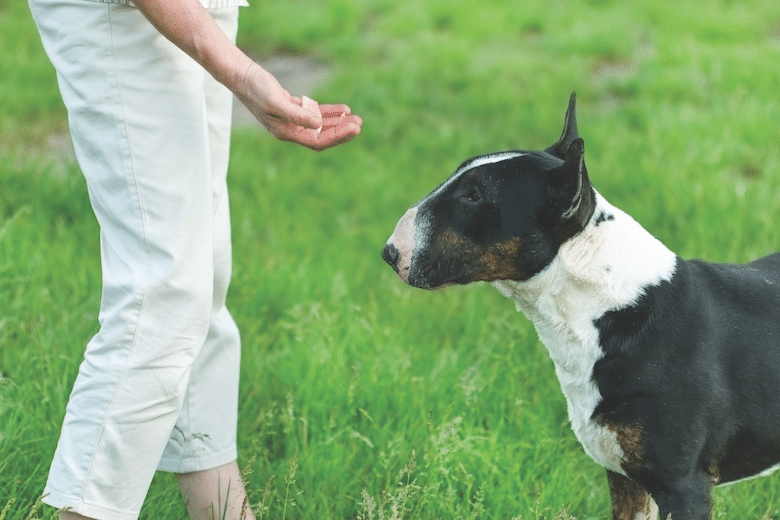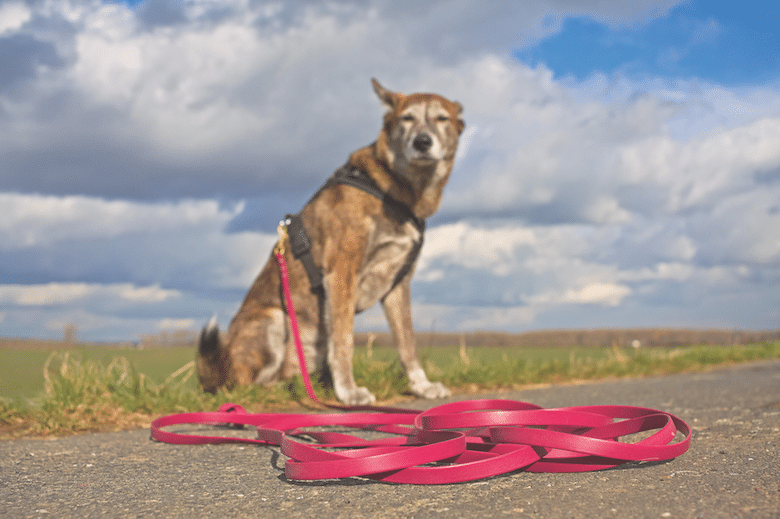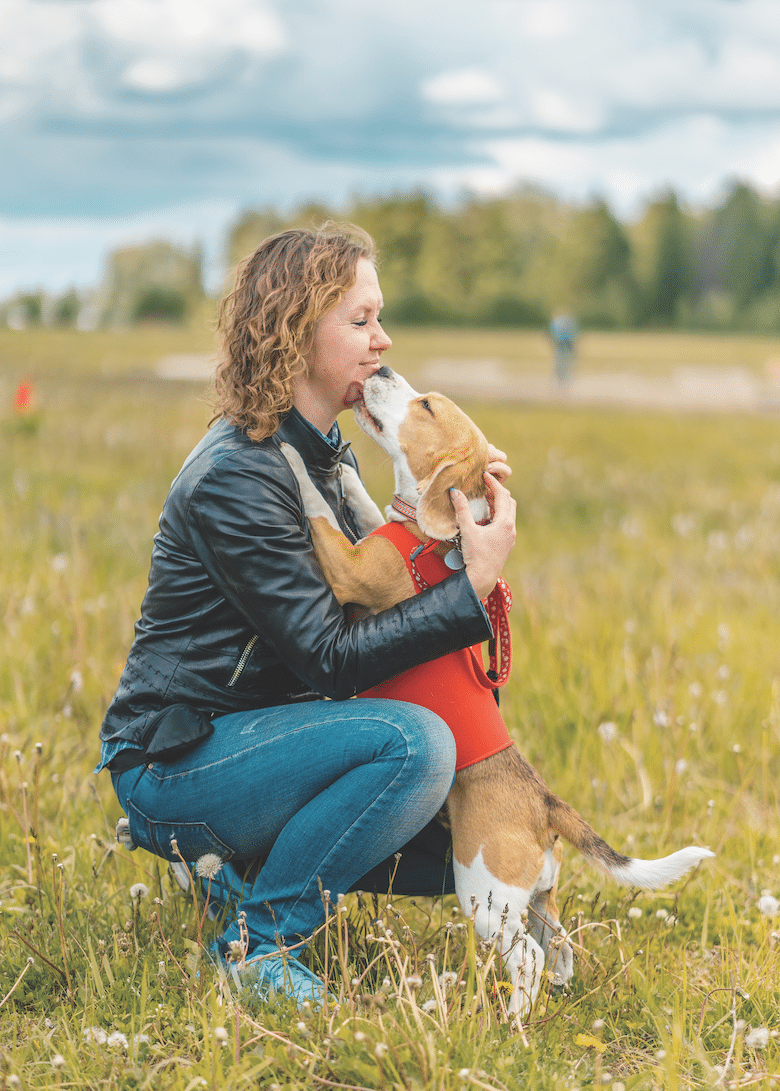The post Recalling Recall: Easy Ways to Teach This Must-know Cue by Paul J. Kearney appeared first on Dogster. Copying over entire articles infringes on copyright laws. You may not be aware of it, but all of these articles were assigned, contracted and paid for, so they aren't considered public domain. However, we appreciate that you like the article and would love it if you continued sharing just the first paragraph of an article, then linking out to the rest of the piece on Dogster.com.
Recall! Motivating a dog from point A to point Me. That’s all that recall is. Notice I didn’t say “making,” I said “motivating.” Recall at its core is getting your dog’s attention and, when you do, asking him to “Come” to you and, when he gets to you, rewarding him for doing so.
First, motivate
Get your dog’s attention by saying his name, using a signal like patting the side of your leg or making a funny sound. Do whatever you need to do to get his attention, so he looks at you.
Related: How to Use Food to Motivate Your Dog During Training
Once I motivate a dog to come toward me, I like to take a quick step or two backward or use the hand signal for recall (stick one arm straight out in front of you and wave it across your chest then pull your hand toward your opposite shoulder) to add some extra incentive to keep the dog coming. For most dogs, this adds a little extra pep in the step when coming toward us.
Next, pair the cue
As the dog comes toward me, I help learning happen by pairing the future verbal cue “Come” with the action of when the dog physically runs from point A to point Me. When the dog gets to me, I use a marker — saying “Yes” or clicking with a clicker — at the completion of the behavior. Then it’s time to provide a reinforcer as a reward.
Pairing is simply saying a word as an action is occurring. As we continue to do this, an emotional bond between the word and the action creates an association for the dog. This creates a secondary reinforcement value between the two things — word and action — that is slowly loaded over a duration of time, creating a reinforcement history in each repeating occurrence. Pairing is best timed to when the dog shows that little pep in the step, while happily running toward you. Pairing the future verbal cue at the moment the dog is running to you helps additionally condition this word to the action.

Reward your dog for coming to you with a celebration — high praise, a yummy treat or a favorite toy. Behaviors with positive outcomes are more likely to be repeated. Photo: lola1960 | Getty Images
And then reward
After getting your dog’s attention and using the verbal cue “Come,” give the dog a jackpot reward/reinforcement like a favorite treat or toy. You want to throw a party to make recall always awesome. Then all you’ll have to do when you want your dog to come to you is say the verbal cue “Come,” and your dog will come running to you.
Personally I am nearly always rewarding recall with my dogs and those rock-star recalls — those with lots of hustle where they’re extra happy to show up — get the jackpots of rewards. Behaviors with pleasing outcomes are more likely to be repeated, so celebrate the wins with your teammates. Recall is for life.

Photo: Stefanie Heufelder | Alamy Stock Photo
Managing the environment
Manage the environment, be aware of your surroundings and, most of all, be respectful of the environment and others enjoying being outside with their dogs.
These three tips will help:
- Teaching your dog anything new is best learned in a neutral environment, one with fewer distractions at first, like inside your home.
- Next, progress to your backyard before going out into a real-world environment. Baby steps or successive approximations are vital to help our dogs learn incrementally as we move forward in teaching them.
- In the early stages of learning recall outside, use a harness attached to a long line. I use a 30-foot long line most often. Longer ones can be used also, but 30 feet is a great size to have for many reasons beyond learning recall. Long lines can be held or dropped on the ground as long as your dog is not running off at full speed. You can always step on the line, but be very careful and mindful of your dog not reaching the end of the lead at speed and banging the lead. This can result in an injury, and it certainly isn’t fun.
Check in
Check In is something I teach as a short-range rapid recall. This recall can be used connected to a standard 6-foot lead on a walk or a 30-foot-long line on a hike. Teaching Check In takes getting your dog’s attention and, when your dog stops and looks back at you, motivating him to come toward you. When he gets to you and completes the behavior, you then mark “Yes” and reinforce with a reward (pea-sized food reward). I keep Check In charged, and it gets random jackpot amounts of super high-value rewards for those rock-star moment celebrations. Check In is kept fun and associated to super high-value rewards, and is always celebrated.
Once Check In has a reinforcement history and becomes reliable, I use it as a rapid Check In. When a high-arousal dog plays or overexuberant puppies harass older dogs, it’s a way of asking for a high-speed check in with me away from a stimulus in their immediate environment. In multiple dog families, Check In can be signaled to each dog by using his name first: “Bear, Check in.” Requesting a dog to check in with you individually gives some one-on-one time with each dog.
Recall with a whistle
If you want to use a whistle for recall, start with a whistle and 10 pea-sized food rewards. Blow the whistle softly with two sharp blows (“tweet, tweet”) and give your dog one piece of food. Repeat the sequence of blowing the whistle (“tweet, tweet”) and giving one piece of food each time until all pieces of food have been given. This will “load” the whistle, generating an association of the food reinforcer and the blow of the whistle.
To teach whistle recall, get your dog’s attention and blow the whistle while backing up a few steps to motivate him to come toward you. When he gets to you, reinforce the completion of this new behavior with a verbal marker (or click) “Yes” and reinforce with another food reward.
After enjoying this new and wonderful game of coming to you when he hears the whistle and being reinforced and rewarded for doing so, slowly increase distances, distractions and durations intermittently to ensure the dog’s success, which motivates him to continue learning. Keep it fun! Whistle recall is something I personally choose to always reinforce with a reward, for life.
Keep recalls charged
Actively maintain a reinforcement history of rewarding recall with your dog for life. I am someone who is always reinforcing recall with something I can give to my dog, besides just praise. On hikes I carry a few pieces of dehydrated beef in my pockets to use as rewards. Be prepared to maintain and increase a reinforcement history with your dog to gain ever more reliability with recall.

Photo: Mordolff | Getty Image
Capturing: When recall just happens
Capturing is a naturally occurring behavior — those times when your dog runs to you on his own — and then you mark and reinforce it.
- This just takes being prepared with something to use as a reinforcer to give to your dog as a reward. For example, your dog could be playing on his own in the backyard while you are gardening and, at the moment he decides to run over to you, you have something to give your dog as a reward. You will be further developing a reinforcement history of your dog choosing to run to you.
- Even praise, with its secondary reinforcement value, will work in these scenarios.
- However, what makes it a jackpot reward is if you are prepared with something you know your dog loves and use it as a reinforcer.
Learn best when having fun
When recall is enjoyable and rewarding, it is fun and rewarding in itself. There are tons of recall games you can play with your dog — ping-pong style games in between two people, come-find-me type games, the run-away-and-catch-me game and the naturally occurring games that happen when your dog hears you open a bag of something yummy and happily runs to you on his own.
Recall should always be fun for your dog to come running to you to be rewarded. Always move at the individual dog’s pace of learning for success, and don’t forget to celebrate the wins.
Featured photo: Holly Hildreth Photography
Read Next: What Is Positive Reinforcement Training for Dogs?
The post Recalling Recall: Easy Ways to Teach This Must-know Cue by Paul J. Kearney appeared first on Dogster. Copying over entire articles infringes on copyright laws. You may not be aware of it, but all of these articles were assigned, contracted and paid for, so they aren't considered public domain. However, we appreciate that you like the article and would love it if you continued sharing just the first paragraph of an article, then linking out to the rest of the piece on Dogster.com.
Poop4U Blog
via www.Poop4U.com
Paul J. Kearney, Khareem Sudlow


No comments: